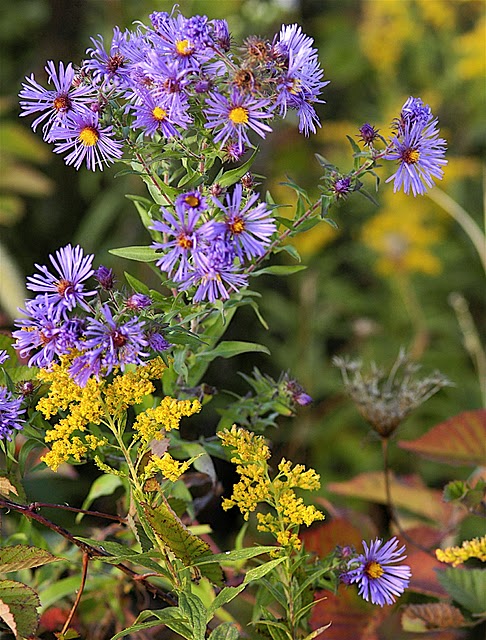Of course, to describe a New England aster merely as purple, is like saying the Grand Canyon is a big hole. As a description it is both monumentally understated while failing entirely to convey any sense of the breathless wonder induced in the viewer. The purple of the New England aster isn’t a mundane purple; rather it’s a magnificent electric purple. A kingly Tyrian purple, like the dye the ancient Romans once obtained from a certain species of mollusk. An imperial purple, of a shade long reserved for the fabrics worn by monarchs and magistrates.
Up close, a single flower head of New England aster atop its stout, waist-high stem, is a vision of astonishing beauty. Two inches across, with a golden center disk around which numerous bright purple rays radiate like light from a miniature amethystine sun.
Now, back off a pace or two, and look at the whole plant. Not one miniature sun but a multitude of a dozen or more suns, clustered about the stem, each afire in incandescent purple glow. And that’s just the power of a single blooming New England aster plant. In fact, asters seldom grow alone. A clump of three or four, maybe a dozen, is more the norm.
A thick swath of blooming New England asters bordered by an autumn woods in shades of red and yellow and orange, is truly a sight to behold. If there are a few goldenrods and a lingering Queen Anne’s lace or two nearby, so much the better.
But it's always the cool starry fire of purple asters that provides the scene with depth and richness. Simply put…asters leave me awed.
———————



12 comments:
Truly awesome, Grizz!
These are lovely photos of asters, Grizz, and your description of the roots of the word "aster" brings to mind one of my favorite Latin expressions, "Per aspera ad astra," which is sometimes stated, "Ad astra per aspera." In any event, the phrase is wide translated to mean "through difficulty to the stars." I've always found that to be a pretty good description of life's journey, which is made lovelier today by your posting. Thanks.
Solitary…
Thank you. And I'm sorry to be so slow in replying—but I somehow managed to get myself tangled up in a bunch of chores and errands and just now finally touched base back here at the desk.
I love the purple of these New England asters. They're not only an icon of the season, but one of my favorite wildflowers of the year.
George…
Can't say I've ever heard either version of that phrase—but I like the translation. The paradox of life lies in the concurrent duality of its simplicity and difficulty…and always with those stars out there to aim for and help us find our way.
Be well and follow the call…
So love the picture of the asters Grizz, I love how you seldom find them alone but others bloom beside them. You do take wonderful pictures my friend....:-) Hugs
'Per ardua ad astra' is also the motto of the British Royal Air Force.
Bernie…
I love the color purple, anyway—and especially in flowers. So big bold clumps of New England asters not only dominate the landscape, they have become for me the quintessential bloom of autumn as necessary as scarlet maples and wedges of geese high overhead.
I don't believe it's possible to take a bad aster photo.
Solitary…
It would certainly make for a good motto. I still can't figure how I've missed encountering it in my reading all these years.
I really enjoyed this post. I'm awed by them too. This sentence is so true: "A hillside of blooming asters is like looking at a tawny sky spangled with gleaming purple stars." I love walking the Little Miami in autumn, because the asters are so thick along the edges of the trail.
D'oh! I tried to shoot asters this morning and, between a persistent wind and a congested head, failed miserably. You did 'em proud, Grizz.
Kelly…
Because of our dry summer, this may not turn out to be the best year for fall color, but around here anyway, it's turning into a great one for fall asters.
I don't know which portion of the Little Miami trail you favor, but I was recently on the sections below Spring Valley and also below Caesar's Creek, and both those areas were a riot of asters and goldenrod.
Jain…
Haven't had any congestion, but I've been dealing with wind, too—especially on the prairie patches. It can frustrate you something awful… but there's not much you can do about it except try and shoot early and learn to be patient. Some days I give up on a subject without managing a single usable shot.
These asters, however, were easy; no wind.
Post a Comment